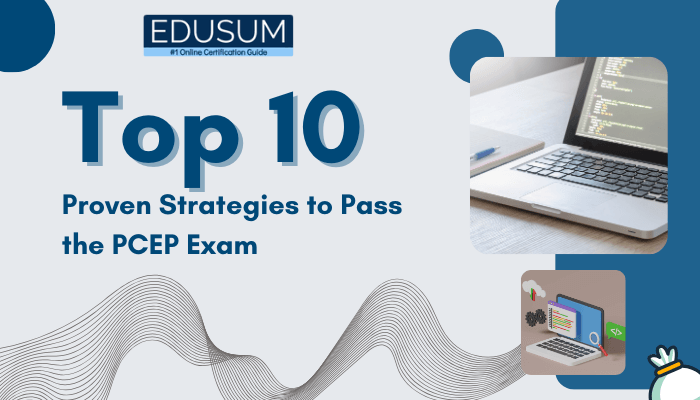 The PCEP: Python Institute Certified Entry-Level Python Programmer certification is an internationally recognized credential that validates foundational Python programming skills. It is ideal for beginners, students, and professionals looking to start a career in programming. The PCEP exam assesses a candidate's ability to understand Python fundamentals, control flow, data collections, and functions.
The PCEP: Python Institute Certified Entry-Level Python Programmer certification is an internationally recognized credential that validates foundational Python programming skills. It is ideal for beginners, students, and professionals looking to start a career in programming. The PCEP exam assesses a candidate's ability to understand Python fundamentals, control flow, data collections, and functions.
Earning a PCEP certification is a great way to kickstart your programming journey and gain an edge in job applications. With proper preparation and practice, passing the PCEP-30-02 exam is entirely achievable.
PCEP Certification Exam Overview:
Before diving into preparation tips, let’s explore the PCEP certification exam structure:
-
Exam Name: Python Institute Certified Entry-Level Python Programmer (PCEP)
-
Exam Price: $69 (USD)
-
Duration: 40 minutes
-
Number of Questions: 30
-
Passing Score: 70%
PCEP certification Exam Topics:
-
Computer Programming and Python Fundamentals (18%)
-
Control Flow – Conditional Blocks and Loops (29%)
-
Data Collections – Tuples, Dictionaries, Lists, and Strings (25%)
-
Functions and Exceptions (28%)
Benefits of PCEP Certification
1. Entry-Level Recognition
The PCEP certification is perfect for beginners looking to validate their Python knowledge and gain industry recognition.
2. Boosts Career Prospects
Certified professionals stand out in the job market, demonstrating their commitment to learning Python programming.
3. Enhances Learning Path
The certification provides a structured learning path, helping candidates build a strong foundation in Python before moving on to more advanced certifications. The PCEP certification is perfect for beginners looking to validate their Python knowledge and gain industry recognition.
Top 10 Tips for Passing the PCEP Certification Exam
1. Understand the Exam Objectives
Go through the official PCEP-30-02 syllabus and understand the topics covered. Prioritize key areas like control flow, loops, and data collections. Reviewing past exam questions can also give insight into frequently tested areas.
2. Take PCEP Practice Tests
Taking a PCEP practice test regularly helps familiarize yourself with the exam format and time constraints. Platforms like Edusum offer high-quality practice exams. Tracking your progress and focusing on weaker areas can greatly improve your score.
3. Master Python Basics
Ensure you have a strong grasp of Python syntax, data types, and basic operations. Online resources like Python Institute and interactive coding platforms can be useful. Practicing small coding exercises daily will reinforce your understanding of the fundamentals.
4. Focus on Code Execution
Since the exam tests practical knowledge, practice writing and running Python scripts. Understand how to debug and optimize your code. Using an interactive Python shell can help you test and understand functions on the go.
5. Learn Conditional Statements and Loops
Around 29% of the PCEP exam focuses on control flow. Master if-else statements, loops (for, while), and conditional expressions to ace this section. Writing small projects that incorporate loops and conditional statements can improve hands-on skills.
6. Strengthen Data Collections Knowledge
Lists, tuples, dictionaries, and strings are crucial in Python. Make sure you can manipulate these data structures efficiently. Try solving common coding problems involving these structures to enhance problem-solving ability.
7. Study Functions and Exceptions
Python functions and exception handling contribute 28% to the exam. Learn how to define functions, use parameters, return values, and handle exceptions correctly. Understanding built-in functions and their use cases will be beneficial.
8. Time Management Strategy
With 40 minutes for 30 questions, you get 80 seconds per question. Avoid spending too much time on any single question. If stuck, move on and return later. Practicing under timed conditions will help develop the ability to think quickly during the exam.
9. Use Official Study Resources
Refer to the official Python Institute study materials and community forums for guidance. Additionally, use structured online courses on platforms. Engaging in discussion forums and study groups can provide valuable insights and clarification.
10. Practice, Revise, and Stay Confident
Regular revision and practice exams help reinforce learning. Stay positive and believe in your preparation. Confidence is key to success. Keeping a revision schedule will ensure you revisit all topics before the exam date.
5 Most Common Questions About PCEP Certification
1. What is the PCEP certification cost?
The PCEP exam costs $69 USD, making it an affordable entry-level certification for Python enthusiasts.
2. How difficult is the PCEP exam?
The PCEP exam is beginner-friendly but requires a strong understanding of Python basics. With consistent practice and mock tests, passing is achievable.
3. How many questions are there in the PCEP exam?
The PCEP-30-02 exam consists of 30 multiple-choice questions to be completed within 40 minutes.
4. Is the PCEP certification worth it?
Yes! The PCEP certification validates foundational Python skills, enhances job prospects, and serves as a stepping stone to more advanced Python certifications.
5. Where can I find PCEP practice tests?
You can take PCEP-30-02 practice tests at Edusum to simulate real exam conditions and boost your confidence
Conclusion
Becoming PCEP certified is a rewarding achievement that can set the foundation for a successful career in Python programming. By following these 10 essential tips, taking a PCEP-30-02 practice test, and leveraging quality study materials, you can confidently pass the PCEP certification exam and take your programming journey to the next level.
Start your PCEP practice test today at Edusum and take a step closer to certification success!
